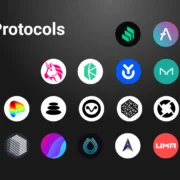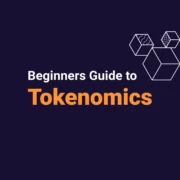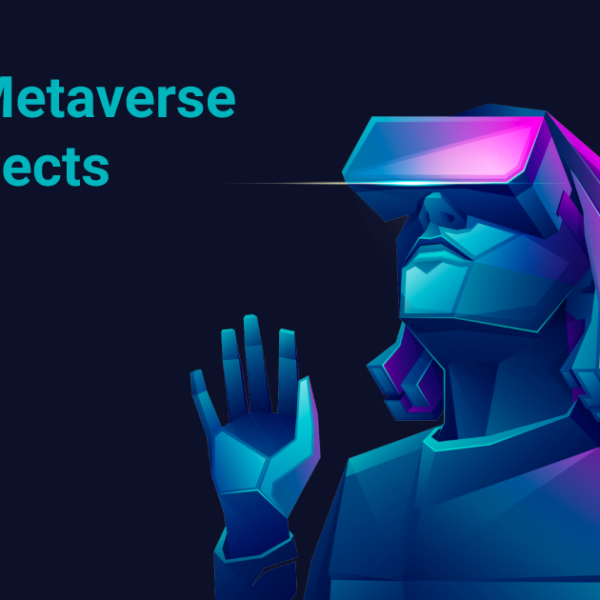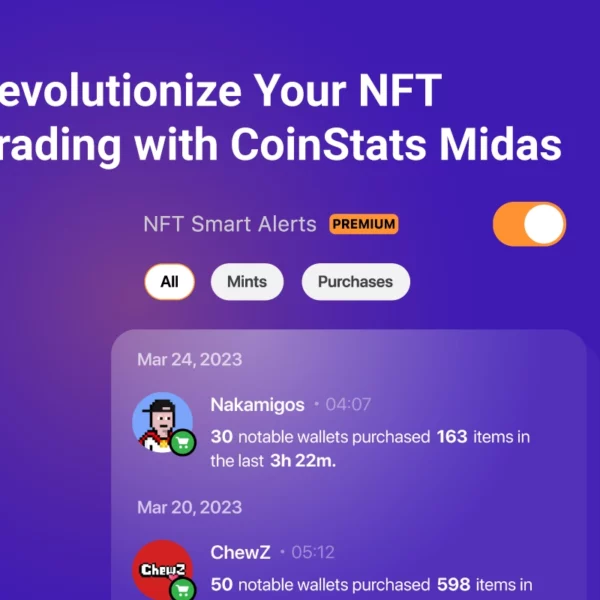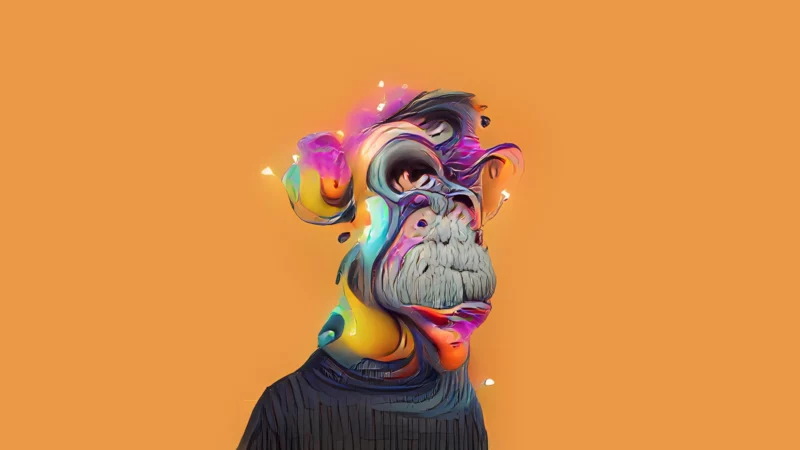
The convergence of Artificial Intelligence (AI) and non-fungible tokens (NFTs) is poised to emerge as a significant trend within the NFT ecosystem. This phenomenon is gaining momentum, mainly within the NFT art sectors, thanks to the introduction of AI algorithms transforming text into artistic creations.
NFT art created by AI algorithms brings new meaning to nonfungible tokens based on AI technologies and the human imagination.
The market for Non-fungible tokens, or NFTs, was worth $41 billion in 2021, close to the total value of the global fine art market.
A non-fungible token (NFT) is a unique digital asset representing ownership or proof of authenticity of a specific item or piece of content, such as artwork, music, virtual real estate, etc., on a blockchain network. Once NFTs have been encoded, they cannot be altered, and their originality and legitimacy are validated through the blockchain.
Artificial Intelligence (AI) has transformed how humans operate, communicate, and engage with information. Its influence expands across various industries, permeating nearly every facet of modern life.
The fusion of AI and NFT art paves the way for novel forms of artistic expression, challenges conventional notions of art, and redefines the relationship between artists, collectors, and technology. It brings a new level of innovation, enabling artists, creators, and enthusiasts to explore the vast possibilities of digital art and collectibles. With AI, you can enhance your artistic vision, generate unique and captivating digital assets, and unlock a world of creativity within the realm of NFTs.
The exciting integration of AI and NFTs can push artistic boundaries, challenge perceptions, and create entirely new artistic experiences.
So how will AI impact the NFT art ecosystem? Are we witnessing the unfolding of an innovative, technologically progressive future for the arts? What are the ethical, authorship, creativity, and authenticity challenges of AI-generated art?
AI’s influence spans far beyond art – for example, AI-driven language models are now used in crypto platforms for chatbots and content creation. Some companies even offer AI LLM optimization services to fine-tune these language models for better user engagement and information delivery.
Let’s delve deeper into these topics and gain a deeper understanding of the profound and multifaceted impact AI has on the NFT art ecosystem.
How NFTs Impact the Arts Industry?
NFTs have become the next great thing ever since artist Beeple sold his Everydays – The First 5000 Days artwork for a whopping $69.3 million at a Christie’s auction in 2021. The sale set a record as the highest-priced NFT sale for an artwork and marked the first time a major auction house offered a purely digital NFT-based artwork.
Widely regarded as the catalyst for the NFT boom in 2021, the sale of Beeple’s artwork played a pivotal role in shaping the NFT market.
The record-breaking transaction represented a significant financial achievement and marked a paradigm shift in the art world. It signified a departure from conventional notions of art, ownership, and value and highlighted the growing influence of digital culture and technology.
Beeple’s triumph symbolized the emergence of a collective movement driven by a generation embracing the digital age, challenging established norms, and transforming the way art is perceived, created, and valued. It inspired a new wave of artists, collectors, and enthusiasts to seize the opportunities offered by blockchain technology and recognize the immense potential of NFTs for reshaping the art landscape.
However, it’s important to acknowledge that the NFT market has experienced fluctuations since its explosive growth in 2021. Recent data from an internal study conducted by Bitcoinbasis indicates that the majority of NFTs have seen a decrease in their prices. This suggests that the NFT market, like any other market, is subject to fluctuations and trends.
Advantages of NFTs for Artists and Collectors
As NFTs continue to gain traction, the potential benefits for artists and collectors are vast. Artists can monetize digital creations, retain control, and engage with global audiences. Simultaneously, collectors can enjoy unique ownership experiences, transparent provenance, and increased accessibility to a diverse array of digital artworks.
Let’s explore some potential benefits NFTs bring to artists and collectors alike.
- Direct Ownership and Authenticity: NFTs enable artists to establish verifiable proof of ownership and authenticate their digital artworks on the blockchain. They provide an immutable and transparent record of ownership, reducing the risk of plagiarism and ensuring the uniqueness and authenticity of the piece. Artwork created with an NFT can never be counterfeited or duplicated. This gives collectors confidence in the authenticity and provenance of their NFT acquisitions.
- Enhanced Royalties and Revenue Streams: NFTs enable artists to earn royalties with each subsequent sale or transfer of their artwork. Through smart contracts embedded in NFTs, artists can automatically receive a percentage of the resale value, ensuring ongoing financial support and recognition for their work. By leveraging NFTs, artists can create new business models, such as subscription services for digital art, and create limited-edition pieces or open editions to be introduced to new collectors at a more accessible price point.
- Democratization of Art: NFTs have the potential to democratize the art world by eliminating the need for intermediaries. Artists can set their own prices for their work without any third-party interference and directly sell their work to collectors, bypassing traditional art galleries or auction houses. This opens up new opportunities for emerging artists to gain recognition and receive fair compensation, while collectors can access a diverse range of artwork directly from the creators. It also helps artists and collectors monetize and protect their digital creations in a secure and decentralized manner.
- Transparency: NFTs offer unparalleled transparency in the art market. Each transaction and ownership transfer is recorded on the blockchain, providing a transparent and tamper-proof history of the artwork’s journey. Moreover, it provides transparency to the pricing of artwork, enabling collectors to evaluate the actual value of a piece based on its price history.
- Global Reach and Accessibility: NFTs remove geographical barriers, enabling artists to connect with a global audience. The digital nature of NFTs allows artworks to be easily shared, discovered, and collected by individuals worldwide, fostering exposure and expanding the artist’s reach beyond traditional art markets. The seamless transfer of the artwork’s ownership worldwide is made possible by the blockchain, eliminating the role of galleries, auction houses, etc.
Success Stories in NFT Art Sales
Many artists and collectors have harnessed the power of blockchain technology to unlock unprecedented opportunities through NFT art sales, where creativity meets financial success. From groundbreaking sales and record-breaking auctions to life-changing profits, these success stories showcase the immense potential of NFT art.
Let’s explore some NFT art sales success stories where artistic visionaries have turned their digital creations into tangible achievements.
Cryptonomist.ch is an online journal dedicated to cryptocurrencies, blockchain, and fintech. It provides news, analysis, and insights on topics such as crypto markets, DeFi, NFTs, Web3, and regulations. The platform covers industry trends, interviews with key figures, and updates on emerging technologies.
The Merge
The Merge is a unique NFT artwork created by a renowned artist going by the pseudonym Pak. Instead of a single piece of work, The Merge is a collection of “masses.” The Merge was sold on Nifty Gateway for a record sum of US$91.8 million — the most expensive NFT ever sold as an artwork.

Clock
Clock is another NFT artwork by Pak sold for $52.74 million. It showcases a muted timer that symbolically tracks the number of days Julian Assange, the Wikileaks founder, has spent in confinement. The NFT artworks were available through a “pay what you want” model on the OpenSea platform. This allowed buyers to tokenize messages and contribute to creating their own unique pieces within the open-edition NFT collection. The collaboration turned out to be a remarkable success.
Human One
Human One is Beeple’s second-most successful NFT artwork sale. It was sold at an auction hosted by Christie’s for $28.9 million. Human One is a futuristic human-like sculpture that appears to be perpetually walking across ever-changing landscapes. To bring his vision of physical-meets-digital art to life, Beeple presented the 3D movement through four video screens telling the story of the first human born in the metaverse.
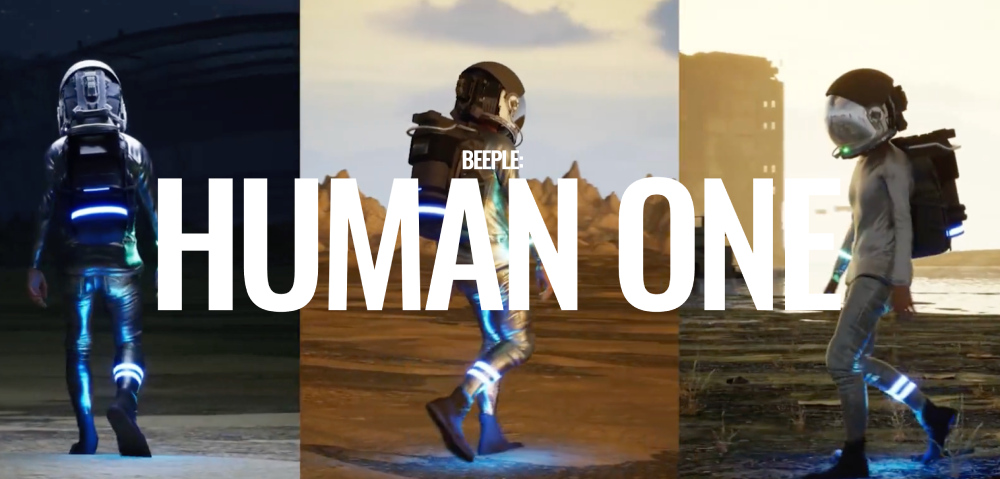
CryptoPunk
CryptoPunk #5822 was sold for 8k ETH, approximately equivalent to a staggering $23.7 Million in 2022. CryptoPunks is a collection of 10,000 tokens called punks. Punks are collectible characters, and no two punks are the same, which makes each CryptoPunk an exclusive item. CryptoPunk #5822 is part of the Alien series collection and has bluish-green skin with a stylish blue bandana. Out of the expansive 10,000-piece collection, only nine aliens exist, further enhancing their exclusivity.
AI and NFT Art: Pros and Cons Explored
The intersection of AI and the NFT art ecosystem has led to innovative applications and new possibilities. AI-adjacent technologies have been used in multiple generative art projects allowing for the production of an infinite array of digital creations, each distinct from the others. Generative art enables artists to input specific parameters and rules into the AI system, creating original artworks based on these guidelines. AI-generative NFTs use Generative Adversarial Networks or GANs, i.e., algorithms leveraging computers and using data to train models to produce machine-made images resembling art. As such, to create a new artwork, an artist must simply enter keywords or sentences into an AI model that will then use algorithms to analyze multiple artworks and produce unique images as a visual representation of the original text. “Edmond de Belamy” is the first AI-generated artwork sold for over $430,000 at a major auction in 2018.
AI algorithms can replicate the artistic style of renowned artists, enabling artists to recreate famous artworks with their own unique twist. By leveraging machine learning techniques, style transfer algorithms generate NFTs with the visual characteristics and essence of iconic art movements or individual artists. For example, Art Blocks is a popular generative art project where users can explore a diverse marketplace of artistic styles, purchase, and subsequently receive generative artworks derived from their preferred artistic style.
AI algorithms also help curate NFT art collections by analyzing various factors such as historical sales data, market trends, and user preferences. This allows collectors and platforms to discover and showcase artworks that align with specific themes, genres, or investment potential.
AI & NFt Art Pros
Let’s explore the numerous advantages AI brings to the NFT art ecosystem.
1. Enhanced Creativity
AI-powered tools and algorithms provide artists with new ways to explore and expand their creativity and produce unique and diverse artworks. These algorithms can create intricate and complex designs not easily achievable through traditional artistic methods alone. These tools include Generative Adversarial Networks (GANs); Image style algorithms; Computer-aided drawing tools; Image classification systems; and Art chatbots.
2. Efficiency
AI can expedite the creation process by automating specific tasks, allowing artists to focus more on conceptualization and creativity. Artists can leverage AI tools to generate many artworks in a fraction of the time it would take using traditional techniques. By employing techniques like GANs, realistic images can be generated within seconds, whereas manually creating similar images would require extensive hours or even days of work. Additionally, image classification systems enable artists to generate multiple images in a short period. This proves particularly valuable for projects requiring various options and proposals for clients. The acceleration in the creative process enables artists to explore a wide range of ideas and experiment with different styles, techniques, and concepts without limitations.
3. Increased Accessibility
AI can lower the barriers to entry for artists by providing accessible tools and platforms for creating NFT art. This allows artists from diverse backgrounds and skill levels to participate and contribute to the NFT art ecosystem, promoting inclusivity and democratization of the art world.
4. Personalization and Customization
AI algorithms can analyze user preferences and create personalized works tailored to individual tastes. This level of customization enhances the connection between the artist, the artwork, and the collector, offering a more personalized and engaging experience.
AI & NFt Art Cons
While AI brings several advantages to the NFT art ecosystem, it’s essential to acknowledge and address the significant challenges and concerns associated with its use. Here are some of the key considerations to explore:
1. Lack of Authenticity
AI-generated art raises questions regarding the artwork’s authorship and authenticity. Since AI-generated artworks are created based on algorithms and training models, many people question whether these works can truly be considered artists’ creations.
Also, AI tools allow people to create accurate copies of existing works of art, raising questions about the authenticity of these copies and their artistic value.
2. Ethical and Privacy Concerns
Using AI in NFT art can lead to ethical dilemmas, particularly concerning copyright infringement and intellectual property. Artists need to carefully navigate the legal aspects and ensure their AI-generated artworks don’t violate any rights or contribute to plagiarism. Other concerns relate to privacy and data security, i.e., creating or manipulating images to deceive or harm people.
3. Devaluation of Human Craftsmanship
The proliferation of AI-generated art may diminish the perceived value of traditional artistic skills and craftsmanship. Traditional art forms often involve meticulously handcrafted techniques and personal artistic choices, which can be overshadowed by the efficiency and speed of AI-generated art. As AI tools allow people to create art more quickly and efficiently, the demand for human artists and job opportunities in the market may decrease. Plus, it can lead to a loss of the uniqueness and subjectivity of art, devaluing the need for individual expression and personal experiences in creating art. While AI can create impressive and visually appealing pieces, there is a risk of losing the unique and individual artistic expression that sets artists apart. This homogeneity can make it difficult for artists to establish a distinct artistic voice and may lead to a lack of diversity and innovation in the art ecosystem.
In conclusion, integrating AI into the NFT art ecosystem should be seen as a collaborative effort where artists and designers work together with technology to unlock new creative possibilities.
Real-world examples demonstrate the potential of AI in generating novel artworks, aiding curation processes, and expanding artistic possibilities. However, it’s crucial to address the ethical implications and ensure a balance between the benefits of AI and the preservation of human creativity and authenticity within the NFT art ecosystem.
Case Studies: Examples of AI and NFT Art
AI-powered tools and algorithms provide artists with new ways to explore their creativity and produce unique and diverse artworks. Plus, AI can expedite the creation process by automating specific tasks, allowing artists to focus more on conceptualization and imagination.
Lastly, AI-generated art can foster inclusivity by democratizing art creation, enabling artists with varying skill levels to produce high-quality pieces.
Most AI generators allow users to create art based on their text of choice and then mint these creations directly to the NFT marketplaces.
Here are some popular AI generators to quickly create NFT art.
NightCafe is a popular and user-friendly AI art generator renowned for its extensive array of algorithms and options. The platform operates on a credit system, offering a generous free tier for users while providing opportunities to “earn” credits by actively engaging with the community. NightCafe enables users to create NFT art and retain complete ownership of their artworks. For those seeking physical copies of their artwork, NightCafe offers the option to purchase high-quality prints. NightCafe is easy-to-use, enabling users to simply type in their text prompt, choose their style, and create!

STARRY NIGHT ASTRONAUT- is one of the top creations generated by NightCafe. It’s the iconic photo of Buzz Aldrin in a space suit, painted in the style of Van Gogh’s “Starry Night.”
StarryAI is an AI art generator enabling users to transform art into NFTs. It’s a free NFT generator with automatic image generation that uses a machine learning algorithm to process images. StarryAI provides complete ownership rights over the generated images, enabling personal and commercial use. The platform also generates images based on textual inputs, offering versatility in creative outputs.
StarryAI opens up new avenues for artistic expression, empowering users to effortlessly generate AI-generated artwork and explore NFT possibilities.
New-age depictions of the Girl in Pearl Earring and The Mona Lisa and the reimagining of the American Gothic are unique NFT artworks created by members of the starryai way.
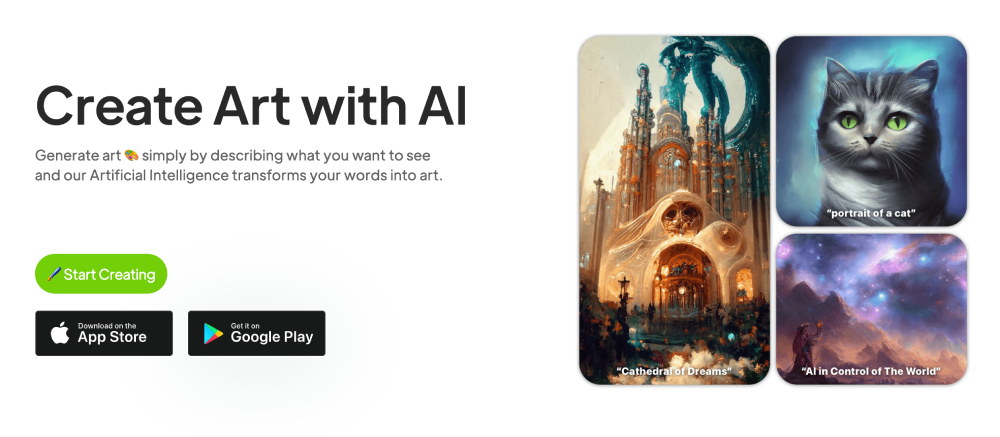
Fotor is another popular, user-friendly AI tool for creating NFT art in minutes. In addition to allowing users to create NFT art, anime avatars, and artistic photos, Fotor is also a comprehensive photo editor. It offers advanced features, enabling users to create layers and add personal touches with a few clicks. Fotor offers an all-in-one photo editing application incorporating traditional editing styles, an AI art generator, graphics, and a template library.
Fotor users can generate AI images from text and can also modify the art styles of their own uploaded custom images and transform any image into a multitude of art styles using creative AI. Simply upload your image and mix it in your preferred art effect style, and the platform will automatically create NFT artwork for you. From Discord PFPs to photos transformed into oil artworks, let your creativity run wild!
Other popular AI art generators include GetIMG, enabling users to generate original images at scale, modify photos, expand pictures beyond their original borders, or create custom AI models; DALL-E 2, used to create illustrations, design products, and generate new ideas for business; Deep Dream Generator enabling users to select a painting style and category to generate images and providing the text to Image software Text 2 Dream, and many others.
Conclusion
AI-generative NFTs are gaining significant traction among the art community and enthusiasts of emerging cutting-edge technologies such as AI, blockchain, and the Metaverse. Integrating AI into the NFT art ecosystem presents exciting opportunities and challenges. Real-world examples demonstrate the potential of AI in generating unique artworks, helping curation processes, and expanding artistic possibilities.
However, it’s crucial to address the ethical implications and ensure a balance between the benefits of AI and the preservation of human creativity and authenticity within the NFT art ecosystem.
To ensure the impact of AI on art is positive and ethical, AI must be viewed as a valuable addition to human creativity, serving as a complement rather than a substitute. Artists should maintain their artistic integrity and retain their personal touch, using AI as a tool to enhance their vision.
